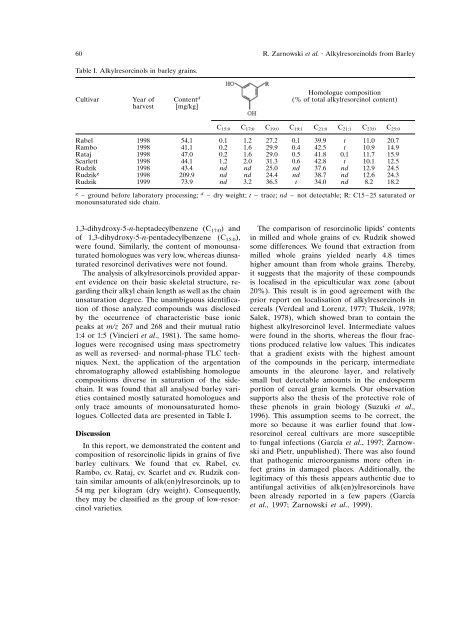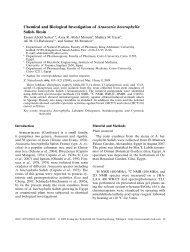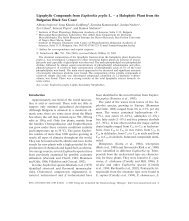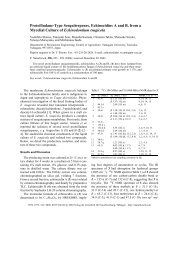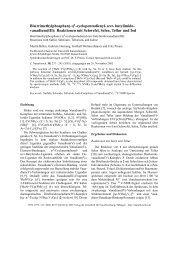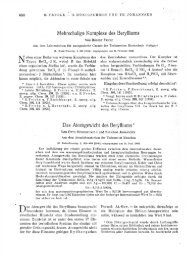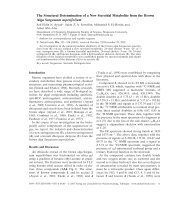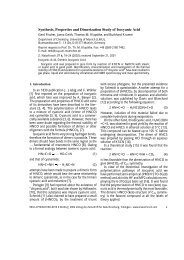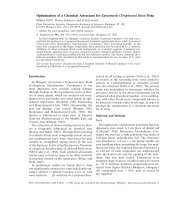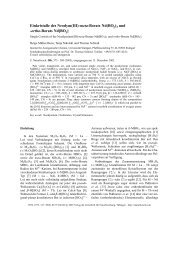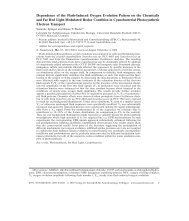Alkylresorcinols in Barley (Hordeum vulgare L. distichon) Grains
Alkylresorcinols in Barley (Hordeum vulgare L. distichon) Grains
Alkylresorcinols in Barley (Hordeum vulgare L. distichon) Grains
Create successful ePaper yourself
Turn your PDF publications into a flip-book with our unique Google optimized e-Paper software.
60 R. Zarnowski et al. · Alkylresorc<strong>in</strong>olds from <strong>Barley</strong><br />
Table I. <strong>Alkylresorc<strong>in</strong>ols</strong> <strong>in</strong> barley gra<strong>in</strong>s.<br />
Homologue composition<br />
Cultivar Year of Content d (% of total alkylresorc<strong>in</strong>ol content)<br />
harvest [mg/kg]<br />
C 15:0 C 17:0 C 19:0 C 19:1 C 21:0 C 21:1 C 23:0 C 25:0<br />
Rabel 1998 54.1 0.1 1.2 27.2 0.1 39.9 t 11.0 20.7<br />
Rambo 1998 41.1 0.2 1.6 29.9 0.4 42.5 t 10.9 14.9<br />
Rataj 1998 47.0 0.2 1.6 29.0 0.5 41.8 0.1 11.7 15.9<br />
Scarlett 1998 44.1 1.2 2.0 31.3 0.6 42.8 t 10.1 12.5<br />
Rudzik 1998 43.4 nd nd 25.0 nd 37.6 nd 12.9 24.5<br />
Rudzik g 1998 209.9 nd nd 24.4 nd 38.7 nd 12.6 24.3<br />
Rudzik 1999 73.9 nd 3.2 36.5 t 34.0 nd 8.2 18.2<br />
g Ð ground before laboratory process<strong>in</strong>g; d Ð dry weight; t Ð trace; nd Ð not detectable; R: C15Ð25 saturated or<br />
monounsaturated side cha<strong>in</strong>.<br />
1,3-dihydroxy-5-n-heptadecylbenzene (C 17:0) and<br />
of 1,3-dihydroxy-5-n-pentadecylbenzene (C 15:0),<br />
were found. Similarly, the content of monounsaturated<br />
homologues was very low, whereas diunsaturated<br />
resorc<strong>in</strong>ol derivatives were not found.<br />
The analysis of alkylresorc<strong>in</strong>ols provided apparent<br />
evidence on their basic skeletal structure, regard<strong>in</strong>g<br />
their alkyl cha<strong>in</strong> length as well as the cha<strong>in</strong><br />
unsaturation degree. The unambiguous identification<br />
of those analyzed compounds was disclosed<br />
by the occurrence of characteristic base ionic<br />
peaks at m/z 267 and 268 and their mutual ratio<br />
1:4 or 1:5 (V<strong>in</strong>cieri et al., 1981). The same homologues<br />
were recognised us<strong>in</strong>g mass spectrometry<br />
as well as reversed- and normal-phase TLC techniques.<br />
Next, the application of the argentation<br />
chromatography allowed establish<strong>in</strong>g homologue<br />
compositions diverse <strong>in</strong> saturation of the sidecha<strong>in</strong>.<br />
It was found that all analysed barley varieties<br />
conta<strong>in</strong>ed mostly saturated homologues and<br />
only trace amounts of monounsaturated homologues.<br />
Collected data are presented <strong>in</strong> Table I.<br />
Discussion<br />
In this report, we demonstrated the content and<br />
composition of resorc<strong>in</strong>olic lipids <strong>in</strong> gra<strong>in</strong>s of five<br />
barley cultivars. We found that cv. Rabel, cv.<br />
Rambo, cv. Rataj, cv. Scarlet and cv. Rudzik conta<strong>in</strong><br />
similar amounts of alk(en)ylresorc<strong>in</strong>ols, up to<br />
54 mg per kilogram (dry weight). Consequently,<br />
they may be classified as the group of low-resorc<strong>in</strong>ol<br />
varieties.<br />
The comparison of resorc<strong>in</strong>olic lipids’ contents<br />
<strong>in</strong> milled and whole gra<strong>in</strong>s of cv. Rudzik showed<br />
some differences. We found that extraction from<br />
milled whole gra<strong>in</strong>s yielded nearly 4.8 times<br />
higher amount than from whole gra<strong>in</strong>s. Thereby,<br />
it suggests that the majority of these compounds<br />
is localised <strong>in</strong> the epiculticular wax zone (about<br />
20%). This result is <strong>in</strong> good agreement with the<br />
prior report on localisation of alkylresorc<strong>in</strong>ols <strong>in</strong><br />
cereals (Verdeal and Lorenz, 1977; Tłus´cik, 1978;<br />
Salek, 1978), which showed bran to conta<strong>in</strong> the<br />
highest alkylresorc<strong>in</strong>ol level. Intermediate values<br />
were found <strong>in</strong> the shorts, whereas the flour fractions<br />
produced relative low values. This <strong>in</strong>dicates<br />
that a gradient exists with the highest amount<br />
of the compounds <strong>in</strong> the pericarp, <strong>in</strong>termediate<br />
amounts <strong>in</strong> the aleurone layer, and relatively<br />
small but detectable amounts <strong>in</strong> the endosperm<br />
portion of cereal gra<strong>in</strong> kernels. Our observation<br />
supports also the thesis of the protective role of<br />
these phenols <strong>in</strong> gra<strong>in</strong> biology (Suzuki et al.,<br />
1996). This assumption seems to be correct, the<br />
more so because it was earlier found that lowresorc<strong>in</strong>ol<br />
cereal cultivars are more susceptible<br />
to fungal <strong>in</strong>fections (García et al., 1997; Z˙ arnowski<br />
and Pietr, unpublished). There was also found<br />
that pathogenic microorganisms more often <strong>in</strong>fect<br />
gra<strong>in</strong>s <strong>in</strong> damaged places. Additionally, the<br />
legitimacy of this thesis appears authentic due to<br />
antifungal activities of alk(en)ylresorc<strong>in</strong>ols have<br />
been already reported <strong>in</strong> a few papers (García<br />
et al., 1997; Z˙ arnowski et al., 1999).


